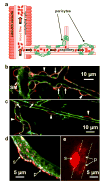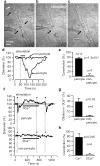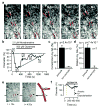Bidirectional control of CNS capillary diameter by pericytes
- PMID: 17036005
- PMCID: PMC1761848
- DOI: 10.1038/nature05193
Bidirectional control of CNS capillary diameter by pericytes
Abstract
Neural activity increases local blood flow in the central nervous system (CNS), which is the basis of BOLD (blood oxygen level dependent) and PET (positron emission tomography) functional imaging techniques. Blood flow is assumed to be regulated by precapillary arterioles, because capillaries lack smooth muscle. However, most (65%) noradrenergic innervation of CNS blood vessels terminates near capillaries rather than arterioles, and in muscle and brain a dilatory signal propagates from vessels near metabolically active cells to precapillary arterioles, suggesting that blood flow control is initiated in capillaries. Pericytes, which are apposed to CNS capillaries and contain contractile proteins, could initiate such signalling. Here we show that pericytes can control capillary diameter in whole retina and cerebellar slices. Electrical stimulation of retinal pericytes evoked a localized capillary constriction, which propagated at approximately 2 microm s(-1) to constrict distant pericytes. Superfused ATP in retina or noradrenaline in cerebellum resulted in constriction of capillaries by pericytes, and glutamate reversed the constriction produced by noradrenaline. Electrical stimulation or puffing GABA (gamma-amino butyric acid) receptor blockers in the inner retina also evoked pericyte constriction. In simulated ischaemia, some pericytes constricted capillaries. Pericytes are probably modulators of blood flow in response to changes in neural activity, which may contribute to functional imaging signals and to CNS vascular disease.
Figures




Comment in
-
Neuroscience: controlled capillaries.Nature. 2006 Oct 12;443(7112):642-3. doi: 10.1038/443642a. Nature. 2006. PMID: 17035989 No abstract available.
References
-
- Attwell D, Iadecola C. The neural basis of functional brain imaging signals. Trends Neurosci. 2002;25:621–625. - PubMed
-
- Cohen Z, Molinatti G, Hamel E. Astroglial and vascular interactions of noradrenaline terminals in the rat cerebral cortex. J Cereb Blood Flow Metab. 1997;17:894–904. - PubMed
-
- Berg BR, Cohen KD, Sarelius IH. Direct coupling between blood flow and metabolism at the capillary level in striated muscle. Am J Physiol. 1997;272:H2693–2700. - PubMed
Publication types
MeSH terms
Substances
Grants and funding
LinkOut - more resources
Full Text Sources
Other Literature Sources

